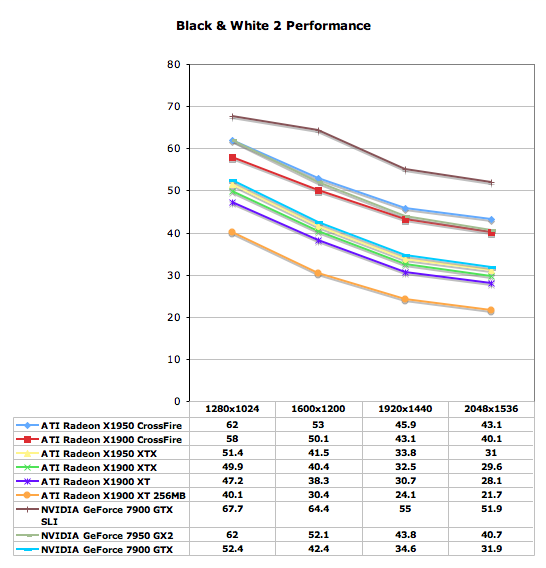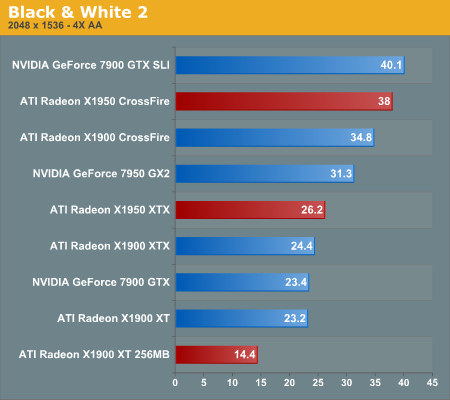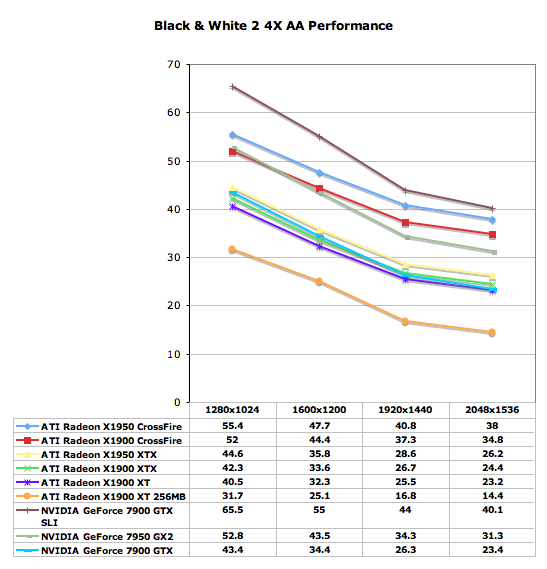ATI's New High End and Mid Range: Radeon X1950 XTX & X1900 XT 256MB
by Derek Wilson on August 23, 2006 9:52 AM EST- Posted in
- GPUs
Black & White 2 Performance
The AnandTech benchmark for Black & White 2 is a FRAPS benchmark. Between the very first tutorial land and the second land there is a pretty well rounded cut scene rendered in-game. This benchmark is indicative of real world performance in Black & White 2. We are able to see many of the commonly rendered objects in action. The most stressful part of the benchmark is a scene where hundreds of soldiers come running over a hill, which really pounds the geometry capabilities of these cards. At launch, ATI cards were severely out matched when it came to B&W2 performance because of this scene, but two patches applied to the game and quite a few Catalyst revisions later give ATI cards a much needed boost in performance over what we first saw.
A desirable average framerate for Black & White 2 is anything over 20 fps. The game does remain playable down to the 17-19 fps range, but we usually start seeing the occasional annoying hiccup during gameplay here. While this isn't always a problem as far as getting things done and playing the game, any jerkiness in frame rate degrades the overall experience.
We did test with all the options on the highest quality settings under the custom menu. Antialiasing has quite a high performance hit in this game, and is generally not worth it at high resolutions unless the game is running on a super powerhouse of a graphics card. If you're the kind of person who just must have AA enabled, you'll have to settle for a little bit lower resolution than we tend to like on reasonably priced graphics card. Black & White 2 is almost not worth playing at low resolutions without AA, depth of field, or bloom enabled. At that point, we tend to get image quality that resembles the original Black & White. While various people believe that the original was a better game, no one doubts the superiority of B&W2's amazing graphics.

So far things aren't looking good for ATI's multi-GPU solution making its way to the top of the charts, as the 7900 GTX SLI significantly outperforms the X1950 CrossFire setup. Once again, we see that the X1950 CrossFire is barely faster than a single 7950 GX2 but, to ATI's credit, Black & White 2 has never been a strength of the X1000 series.
Single card performance is a bit closer, as the 7900 GTX offers the same performance as the X1950 XTX. Although the 7950 GX2 is technically a single card, its dual GPUs let it perform like a multi-card solution, and its price shows. The 7950 GX2 offers an interesting middle ground between the price and performance of a top of the line single GPU solution like the X1950 XTX or 7900 GTX and a full blown multi-card multi-GPU setup.
Once again it's worth noting that even the $280 X1900 XT 256MB is able to average a playable frame rate at 2048 x 1536, making a case for the value to be had in a sub-$300 graphics card.


With AA enabled, the X1950 CrossFire vs. 7900 GTX SLI gap narrows considerably, and on the single card side the X1950 XTX manages to outperform the 7900 GTX. Thanks to better scaling with NVIDIA's SLI, the 7900 GTX more than makes up for the gap when you add a second card.
With 4X AA enabled, the X1900 XT 256MB can no longer hang with the big boys. However, it's worth mentioning that at higher resolutions, the visual benefit of anti-aliasing quickly diminishes. As pixel size decreases, visible aliasing becomes much less of a problem and if it's bothering you that much at 2048 x 1536 we may need to sit you down and have a talk about the old days when we didn't have anti-aliasing (and we had to benchmark in the snow).











74 Comments
View All Comments
Vigile - Wednesday, August 23, 2006 - link
My thought exactly on this one Anand...Anand Lal Shimpi - Wednesday, August 23, 2006 - link
You can run dual monitors with a CrossFire card as well, the CrossFire dongle that comes with the card has your 2nd DVI output on it :)Take care,
Anand
kneecap - Wednesday, August 23, 2006 - link
What about VIVO? The Crossfire Edition does not support that.JarredWalton - Wednesday, August 23, 2006 - link
For high-end video out, the DVI port is generally more useful anyway. It's also required if you want to hook up to a display using HDCP - I think that will work with a DVI-to-HDMI adapter, but maybe not? S-VIDEO and Composite out are basically becoming seldom used items in my experience, though the loss of component out is a bit more of a concern.JNo - Thursday, August 24, 2006 - link
So if I use DVI out and attach a DVI to HDMI adaptor before attaching to a projector or HDTV, will I get a properly encrypted signal to fully display future blu-ray/hd-dvd encrypted content?The loss of component is a bit of a concern as many HDTVs and projectors still produce amazing images with component and, in fact, I gather that some very high resolutions+refresh rates are possible on component but not DVI due to certain bandwidth limitations with DVI. But please correct me if I am wrong. I take Anandtech's point on the crossfire card offering more but with a couple of admittedly small quesiton marks, I see no reason not to get the standard card and crossfire for the second later if you decided to go that route...
JarredWalton - Thursday, August 24, 2006 - link
I suppose theoretically component could run higher resolutions than DVI, with dual-link being required for 2048x1536 and higher. Not sure what displays support such resolutions with component inputs, though. Even 1080p can run off of single-link DVI.I think the idea with CF cards over standard is that they will have a higher resale value if you want to get rid of them in the future, and they are also more versatile -- TV out capability being the one exception. There are going to be a lot of people that get systems with a standard X1950 card, so if they want to upgrade to CrossFire in the future they will need to buy the CrossFire edition. We all know that at some point ATI is no longer going to make any of the R5xx cards, so if people wait to upgrade to CrossFire they might be forced to look for used cards in a year or two.
Obviously, this whole scenario falls apart if street prices on CrossFire edition cards end up being higher than the regular cards. Given the supply/demand economics involved, that wouldn't be too surprising, but of course we won't know for another three or four weeks.
UNESC0 - Wednesday, August 23, 2006 - link
thanks for clearing that up Anand, news to me!TigerFlash - Wednesday, August 23, 2006 - link
I was wondering if anyone thinks it's wise to get an intel core duo 2 motherboard with crossfire support now that AMD is buying out ATI. Do you think ATI would stop supporting Intel motherboards?johnsonx - Wednesday, August 23, 2006 - link
Of course not. AMD/ATI isn't stupid. Even if their cross-licensing agreement with Intel didn't prevent them from blocking Crossfire on Intel boards (which it almost surely does), cutting out that part of the market would be foolish.
dderidex - Wednesday, August 23, 2006 - link
What's with the $99 -> $249 gap?Weren't we supposed to see an X1650XT, too? Based on RV570? ...or RV560? Something?